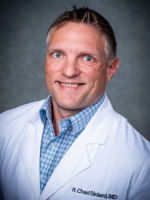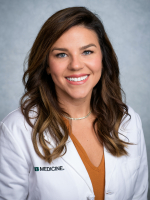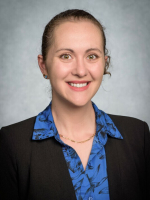UAB's Department of Pathology offers flexible and individually-tailored programs in Anatomic Pathology and Clinical Pathology, or combined AP/CP, leading to board eligibility in each area. Residency training in each area encompasses the understanding of disease at macroscopic, microscopic, and molecular levels. Electives, including specialty fellowships, clinical research fellowships, and other approved training, are available to satisfy board requirements. The ACGME accredited program is supported by UAB's Heersink School of Medicine Graduate Medical Education.
Program Mission
The mission of the University of Alabama at Birmingham Pathology Residency Program is to train successful pathologists with a focus on quality patient care, in-depth diagnostic knowledge, and comprehensive professional development by providing an exceptional and research-rich learning environment in all disciplines of Anatomic and Clinical Pathology.
Program Aim
To train residents with a broad range of medical knowledge, professional judgement, and technical skills with an overall goal of independent practice, board-certification, and successful employment in a desired setting (community, private, and/or academic).
Meet our Program Directors
Anatomic Pathology
Residency training in anatomic pathology focuses on analyzing the disease process in cells, tissues, and organs obtained from many sources, including cytologic washings and brushings, endoscopies, surgical operations, and autopsies. Primary experience is gained through rotations in surgical pathology, cytopathology, and autopsy pathology. Subspecialty experience is gained from experts in all areas of surgical pathology as well as forensic pathology, molecular pathology, and neuropathology.
AP residents are given a broad exposure to pathologic processes while stressing clinico-pathologic correlation. Residents have the opportunity to learn fine-needle aspiration performance and interpretation as cytologic evaluations are an integral part of the cytology experience. Rotations are graduated to give additional responsibility as skills are obtained and refined particularly in autopsy as residents are transitioned into peer teachers near the conclusion of their rotation. Residents may also teach undergraduate health professions students on an ad hoc basis or part of a teaching elective experience, and they can participate in a didactic lecture series, conferences, and other meetings.
Laboratory Medicine
Residency training in laboratory medicine focuses on the interpretation of laboratory results, technical aspects of modern laboratories, and laboratory management through active participation with faculty and laboratory personnel. The training provides core experience through rotations in clinical chemistry, microbiology, clinical immunology and molecular diagnosis, transfusion medicine, immunocytology, and clinical hematology/hemostasis.
The transfusion medicine rotation allows residents to be active members of the healthcare team that oversees the release of blood products, therapeutic apheresis procedures, and apheresis collections with the UAB Apheresis Service. Residents are given graduated responsibility with a focus on operations in areas in transfusion, apheresis, and coagulation.
After the initial rotations, training in laboratory medicine is tailored through subspecialization to the individual's career goals. Laboratory medicine residents are exposed daily to management and administration practices through the didactic lecture series, special projects (such as involvement in CAP inspections), and lab administration coursework.
Research
Residency involvement in research is strongly recommended by the department, and funding for individual resident projects is available. UAB ranks among the top 10% of pathology residency programs in numbers of poster presentations at the USCAP meeting (2007). Residents with an interest in basic science and academic careers may do post-doctoral work in any specialty at UAB as a part of their AP/CP training. Support is guaranteed for up to six months credit toward board certification and additional support can be acquired while on the Physician-Scientist Research Pathway to board certification. Research time is focused on the individual career goals of the young investigator and is directed toward the development of independent and successful investigators with a base in Pathology. A Physician-Scientist Development and Mentorship Committee is involved throughout this process. The UAB Stimulating Access to Research in Residency (StARR) Program, funded by an NIH NIAID R38 award, supports mentored research and career development activities for residents.
The Department of Pathology allows trainees to work not only within the Department but also throughout the Medical Center in a laboratory that best fits their career goals. Research in our department spans the spectrum of basic, transitional, and applied science, with basic research programs centering on molecular biology, signal transduction, cancer biology, extracellular matrix, biochemistry, bone metabolism, growth factor biology, cardiovascular biology, AIDS pathophysiology, and immunopathology, Applied research projects include health services research, laboratory informatics, gene therapy, biomarkers, embryo/fetal pathology, crystallography, and research on clinical outcomes. Research time is focused on the individual career goals of the young investigator and is directed toward the development of independent and successful investigators with a base in Pathology.
Supervision and Training
Residents assigned to rotations are supervised by faculty who have direct involvement with each case. When residents are assigned to observe and master certain technical skills, additional supervision and instruction are provided by the faculty member or technical expert in the appropriate section of the laboratory. Under supervision by the faculty within each rotation, the residents are actively involved in diagnosis and analysis of information, as well as correlating laboratory data with the clinical history. Residents are expected to participate in diagnostic decisions and are encouraged to express their opinion on the analysis of laboratory data. An important function of faculty supervision in each rotation is to assist the residents in identifying their limitations and weaknesses, to seek additional expertise in complicated cases, and to direct residents to sources of continuing education.
The University of Alabama Hospital is a tertiary care referral hospital as well as a community hospital and, as such, provides a wide range of diagnostic material for pathologists and the Pathology Residency Training Program. Rotations in Pediatric Pathology are available through the Children's Hospital of Alabama, the only children's hospital in the state. Forensic Pathology training is available in conjunction with the Jefferson County Medical Examiners Office at Cooper Green Hospital, adjacent to the Medical Center. All of the Medical Examiners are faculty members in the Department of Pathology.
Pathology residents share the above facilities with over 470 other residents from 26 accredited programs at UAB. Training resources available to residents and fellows include over 70 Centers of Research among which are the following: Arthritis,Cancer, Cardiovascular Diseases, AIDS, Macromolecular Crystallography, Oral Biology, Cystic Fibrosis,Diabetes, and Neurobiology, Aging, Metabolic Bone Disease, Cell Adhesion and Matrix, Spinal Imaging, and Genetics. The Department of Pathology actively participates in all of these centers. In addition, we have over 29,000-square-feet of research space within the Department.
Data indicate the diagnostic resources which are available for clinical experience in Anatomic Pathology: the autopsy service (245 accessions), forensic autopsies (1,351 accessions), surgical pathology (41,224 accessions), and cytopathology (13,073 GYN specimens and 8,153 non-GYN). There are many other sources of diagnostic material . For example, UAB is the largest renal transplant service in the world, and there are also large and active programs in lung, heart/lung, liver, pancreas, small bowel, and bone marrow transplantation. Embryo and fetal pathology, and metabolic bone studies are also a rich source of material. Clinical experience for Laboratory Medicine draws from a patient base of greater than one million, generating 7 million tests at University Hospital and 1.8 million tests collectively at Children's Hospital and the Veterans Administration Hospital.
Teaching
Residents plan and conduct teaching and conferences within the Department of Pathology, the Heersink School of Medicine, and the School of Dentistry, Optometry, and Health-Related Professions. They also participate in interdisciplinary conferences. Faculty members supervise teaching by the residents. Teaching is usually in the context of scheduled classes for undergraduate, medical, dental, and optometry students, or conferences within the Department of Pathology or other departments. In the Division of Anatomic Pathology, teaching centers around the Autopsy Service, Surgical Pathology, Cytopathology, and various subspecialty conferences. In addition, residents may participate in didactic sessions or medical, dental, optometry and health-related professions students.
In Clinical Pathology, the primary forum for teaching is the Laboratory Medicine Presentation Series. This series includes the Laboratory Medicine Seminar in which the resident is trained to identify a problem in laboratory medicine, research the literature, analyze the data, and formulate and present conclusions. Residents also present in Laboratory Medicine Journal Club and Case Presentations, which are team-taught with a co-resident and focuses on working through the clinic-pathologic correlation of a published case report. In addition, residents present in-service lectures during all clinical rotations.


